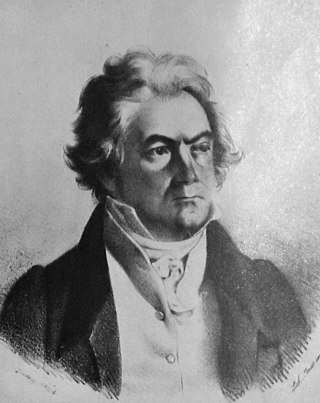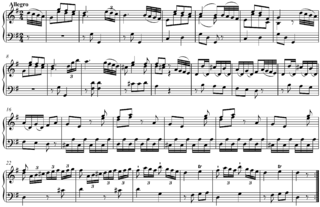This article needs additional citations for verification .(March 2022) |
Sonata rondo form is a musical form often used during the Classical and Romantic music eras. As the name implies, it is a blend of sonata and rondo forms.
This article needs additional citations for verification .(March 2022) |
Sonata rondo form is a musical form often used during the Classical and Romantic music eras. As the name implies, it is a blend of sonata and rondo forms.
Rondo form involves the repeated use of a theme (sometimes called the "refrain") set in the tonic key, alternating with episodes, resulting in forms such as ABACA (the five-part rondo) or ABACADA (the seven-part rondo). In a rondo, the refrain (A) may be varied slightly. The episodes (B, C, D, etc.) are normally in a different key than the tonic.
Sonata form is a classical form composed of three main sections, namely exposition, development, and recapitulation. A sonata may begin with an introduction, which is commonly slower than the remainder of the movement. After that, there is an exposition, whose purpose is to present the movement's main thematic material. This takes the form of one or two themes or theme groups, the second of which is commonly in a related key. The exposition may conclude with a short codetta and/or closing theme and may be repeated. This is followed by the development section, in which existing thematic material may be presented in new harmonic and textural contexts and/or entirely new material may be introduced. Next comes the recapitulation, where all themes or theme groups from the exposition are presented again but now in the tonic key. Sonatas may optionally end with a final large section called the coda.
The following shows the structure of sonata form. In the notation, a single prime (') means "in the dominant" and a double prime (") means "in remote keys".
Occasionally, sonata form includes an "episodic development," which uses mostly new thematic material. Two examples are the first movements of Mozart's piano sonata K. 330 and Beethoven's piano sonata Op. 14, no. 1. [1] The episodic development is often the kind of development that is used in sonata rondo form, to which we now turn.
Sonata rondo form combines features of the five-part rondo and sonata form. [2] The simplest kind of sonata rondo form is a sonata form that repeats the opening material in the tonic at the end of the exposition and recapitulation sections.
By adding in these extra appearances of A, the form reads off as AB'AC"ABA, hence the alternation of A with "other" material that characterizes the rondo. Note that if the development is an episodic development, then C" will be new thematic material—thus increasing the resemblance of sonata rondo form to an actual rondo.
Mozart sometimes used a variant type of sonata rondo form in which the first "A" section of the recapitulation is omitted. Thus:
Mozart's purpose was perhaps to create a sense of variety by not having the main theme return at such regular intervals. He used the form in the finales of his piano quartets and a number of his piano concertos.
Another six-part sonata rondo form may be written as:
This instance occurs in the 4th movement of Tchaikovsky's Symphony No. 6 in B minor.
Often, regular sonata form includes a coda:
This longer version of sonata form has a counterpart in sonata rondo form.
Thus: AB'AC"ABAD. An example is the last movement of Beethoven's "Pathetique" Sonata, Op. 13.
It is also possible to describe sonata rondo form by starting out with rondo form and describing how it is transformed to be more like sonata form. For this explanation, see rondo.
Cuthbert Girdlestone conjectured in his "Mozart and His Piano Concertos" that the sonata rondo form derives also in part from the dances en rondeau of Jean-Philippe Rameau, among others, by structural elaboration, possibly an innovation of Mozart's. [3]
Sonata rondo form is almost exclusively used in the finales of multi-movement works. [4] It is considered a somewhat relaxed and discursive form. Thus, it is unsuited to an opening movement (typically the musically tightest and most intellectually rigorous movement in a Classical work). It is, exceptionally, used in the opening Andante movement of Haydn's D-major piano sonata Hob. XVI:51. [5] Here are some movements written in sonata rondo form:
Sonata form is a musical structure generally consisting of three main sections: an exposition, a development, and a recapitulation. It has been used widely since the middle of the 18th century.
The Piano Sonata No. 16 in C major, K. 545, by Wolfgang Amadeus Mozart was described by Mozart in his own thematic catalogue as "for beginners", and it is very commonly known by the nickname Sonata facile or Sonata semplice. Despite this, the sonata is actually not an easy work to perform and can hardly be described as "for beginners."

The Symphony No. 8 in F major, Op. 93 is a symphony in four movements composed by Ludwig van Beethoven in 1812. Beethoven fondly referred to it as "my little Symphony in F", distinguishing it from his Sixth Symphony, a longer work also in F.

Ludwig van Beethoven's Piano Sonata No. 29 in B♭ major, Op. 106 is a piano sonata that is widely viewed as one of the most important works of the composer's third period and among the greatest piano sonatas of all time. Completed in 1818, it is often considered to be Beethoven's most technically challenging piano composition and one of the most demanding solo works in the classical piano repertoire. The first documented public performance was in 1836 by Franz Liszt in the Salle Erard in Paris to an enthusiastic review by Hector Berlioz.

Beethoven's Piano Concerto No. 3 in C minor, Op. 37 is generally thought to have been composed in 1800, although the year of its composition has been questioned by some contemporary musicologists. It was first performed on 5 April 1803, with the composer as soloist. During that same performance, the Second Symphony and the oratorio Christ on the Mount of Olives were also premiered. The composition was published in 1804, and was dedicated to Prince Louis Ferdinand of Prussia. The first primary theme is reminiscent of that of Mozart's 24th Piano Concerto.
Cyclic form is a technique of musical construction, involving multiple sections or movements, in which a theme, melody, or thematic material occurs in more than one movement as a unifying device. Sometimes a theme may occur at the beginning and end ; other times a theme occurs in a different guise in every part.

Ludwig van Beethoven's Piano Sonata No. 3 in C major, Op. 2, No. 3, was written in 1795 and dedicated to Joseph Haydn. It was published simultaneously with his first and second sonatas in 1796.

Ludwig van Beethoven is one of the most influential figures in the history of classical music. Since his lifetime, when he was "universally accepted as the greatest living composer", Beethoven's music has remained among the most performed, discussed and reviewed in the Western world. Scholarly journals are devoted to analysis of his life and work. He has been the subject of numerous biographies and monographs, and his music was the driving force behind the development of Schenkerian analysis. He is widely considered among the most important composers, and along with Bach and Mozart, his music is the most frequently recorded.

The String Quartet No. 15 in A minor, Op. 132, by Ludwig van Beethoven, was written in 1825, given its public premiere on November 6 of that year by the Schuppanzigh Quartet and was dedicated to Count Nikolai Galitzin, as were Opp. 127 and 130. The number traditionally assigned to it is based on the order of its publication; it is actually the thirteenth quartet in order of composition.

The Piano Concerto No. 2 in B-flat major, Op. 19, by Ludwig van Beethoven was composed primarily between 1787 and 1789, although it did not attain the form in which it was published until 1795. Beethoven did write a second finale for it in 1798 for performance in Prague, but that is not the finale that was published. It was used by the composer as a vehicle for his own performances as a young virtuoso, initially intended with the Bonn Hofkapelle. It was published in December 1801 as Op. 19, later than the publication in March that year of his later composition the Piano Concerto No. 1 in C major as Op. 15, and thus became designated as his second piano concerto.

Ludwig van Beethoven's Piano Concerto No. 1 in C major, Op. 15, was written in 1795, then revised in 1800. It was possibly first performed by Beethoven at his first public concert in Vienna on 29 March 1795. It was first published in 1801 in Vienna with dedication to his pupil Princess Anna Louise Barbara Odescalchi, known to her friends as "Babette".
The Symphony No. 98 in B♭ major, Hoboken I/98, is the sixth of the twelve London symphonies composed by Joseph Haydn. It was completed in 1792 as part of the set of symphonies composed on his first trip to London. It was first performed at the Hanover Square Rooms in London on 2 March 1792. Some musicologists and historians interpret this symphony as Haydn’s tribute to his friend Mozart who had died on 5 December 1791.

Ludwig van Beethoven's Piano Sonata No. 1 in F minor, Op. 2 No. 1, was written in 1795 and dedicated to Joseph Haydn. It was published simultaneously with his second and third piano sonatas in 1796.

Ludwig van Beethoven's Piano Sonata No. 2 in A major, Op. 2, No. 2, was written in 1795 and dedicated to Joseph Haydn. It was published simultaneously with his first and third sonatas in 1796.
Beethoven's Piano Sonata No. 11 in B♭ major, Op. 22, was composed in 1800, and published two years later. Beethoven regarded it as the best of his early sonatas, though some of its companions in the cycle have been at least as popular with the public.
The Symphony No. 99 in E♭ major is the seventh of the twelve London symphonies written by Joseph Haydn. The symphony was written in 1793 in Vienna in anticipation for his second trip to London.

Ludwig van Beethoven's Piano Sonata No. 22 in F major, Op. 54, was written in 1804. It is contemporary to the first sketches of the Symphony No. 5 in C Minor. It is one of Beethoven's lesser known sonatas, overshadowed by its widely known neighbours, the Waldstein and the Appassionata.

In musical form and analysis, exposition is the initial presentation of the thematic material of a musical composition, movement, or section. The use of the term generally implies that the material will be developed or varied.

The String Quartets, Op. 50, were composed by Joseph Haydn in 1787. The set of six quartets was dedicated to King Frederick William II of Prussia. For this reason the set is commonly known as the Prussian Quartets. Haydn sold the set to the Viennese firm Artaria and, without Artaria's knowledge, to the English publisher William Forster. Forster published it as Haydn's Opus 44. Haydn's autograph manuscripts for Nos. 3 to 6 of the set were discovered in Melbourne, Australia, in 1982.

The Piano Quartets, WoO 36, by Ludwig van Beethoven are a set of three piano quartets, completed in 1785 when the composer was aged 14. They are scored for piano, violin, viola and cello. He composed a quartet in C major, another in E-flat major, and a third in D major. They were first published posthumously in 1828, however numbered in a different order: Piano Quartet No. 1 in E-flat major, Piano Quartet No. 2 in D major, and Piano Quartet No. 3 in C major.